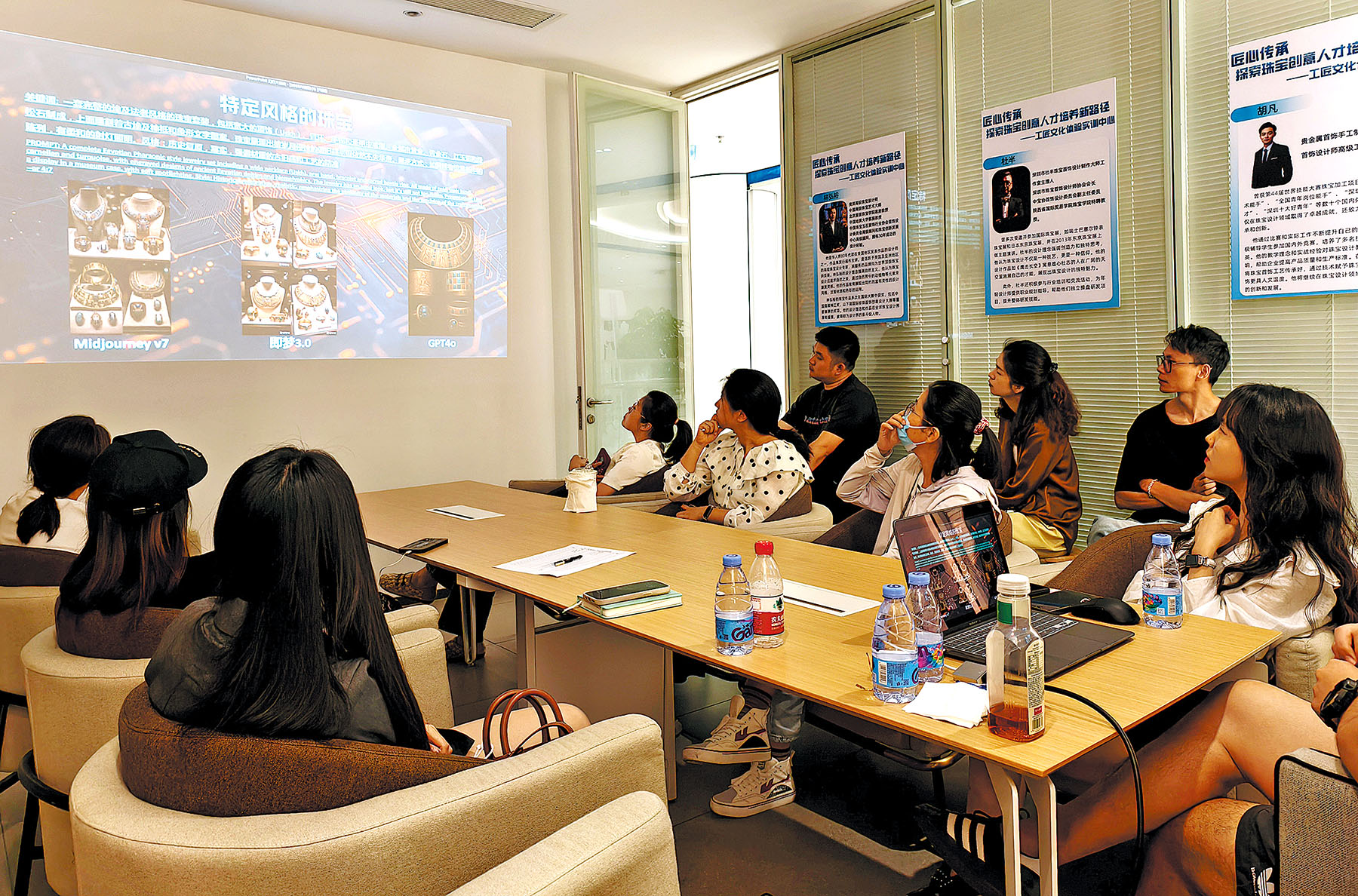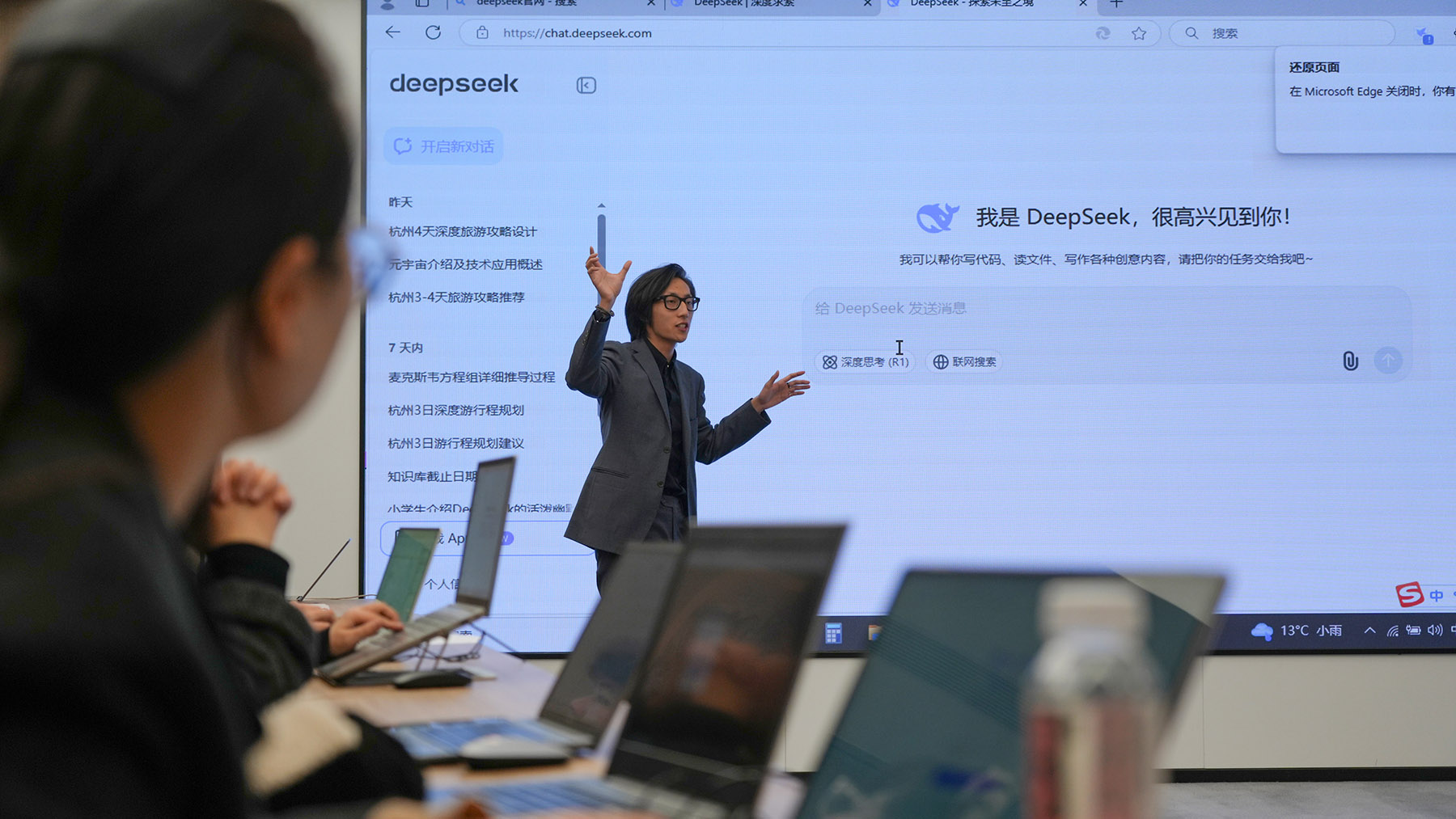The rapid advancement of technology has led to surging demand for artificial intelligence literacy, with enterprises and individuals engaging in AI courses to get ahead of the competition. Zhou Mo and Li Bingcun report from Shenzhen.

For a long time, siblings Fang Zhiyin and Fang Jingmin had been trying to keep their jewelry company afloat in an increasingly competitive industry.
As heirs of the family business, they were fully aware that traditional operating methods no longer met consumers’ growing demand for personalized items and the rapid turnaround of products.
As they explored ways to stay ahead, they came across an artificial intelligence-powered jewelry design course. Organized by Cuizhu neighborhood in Shenzhen’s Luohu district, Guangdong province, the course aims to help businesses enhance their competitiveness and improve individuals’ professional skills by equipping them with the ability to use AI technology.
The siblings, who completed the AI course in March, believed that adopting advanced technology could speed up their company’s development.
“The changes brought by AI-assisted jewelry design have far exceeded our expectations,” says Fang Jingmin, general manager of research and development at Shenzhen Baibaohui Gold Jewelry Co.
READ MORE: Consumers warned over AI courses
The new knowledge has improved their business in multiple areas. Bespoke jewelry that once took several days to design can now be produced using AI in minutes, reducing the design time by 80 percent.
With the help of AI image recognition technology, the company can quickly analyze reference images provided by their clients and better understand their design preferences. This has led to a 35 percent increase in customer satisfaction.
Real-time 3D rendering enables customers to see a design immediately, cutting their decision-making time in half and boosting the overall conversion rate from concept to product by 28 percent.
“In the age of AI, it’s not the technology itself that causes businesses to fail, but the unwillingness of businesses to embrace it,” says Fang Zhiyin, general manager of the company’s commodities department.

New dynamic
The Fangs are among a growing number of people in Shenzhen who have recognized the transformative potential of AI in their work and lives, and are jumping on the technology bandwagon to maintain a competitive edge. Their desire for new tech knowledge aligns with Shenzhen’s commitment to innovation.
Since China’s reform and opening-up policy was implemented in the late 1970s, Shenzhen has undergone a remarkable transformation from a small fishing village to a bustling metropolis and global technology hub. By last year, it had become home to over 25,000 national-level high-tech enterprises, with an average of 12 per square kilometer, the highest density of such companies in the country.
The city launched an action plan in March to accelerate its development as an AI pioneer. It aims to increase the number of AI enterprises to over 3,000 and AI “unicorns” — startups valued at $1 billion or above — to more than 10 by 2026, with annual industrial output growing at over 20 percent.
While the emergence of AI technologies brings fresh opportunities to Shenzhen, it also presents new demands for its workers. The city is stepping up efforts to empower its workforce to adapt to the new dynamic and prepare them for the changing job market.
A number of neighborhoods in the city have rolled out AI training programs, with curricula ranging from skills training and practical operations, to occupational guidance.
Cuizhu neighborhood is one of them and, on weekday nights, classrooms at Shuibei Night School are full. People from diverse backgrounds, including finance professionals, e-commerce sellers, accountants and dentists, have returned to the classroom to absorb the latest tech knowledge.
According to the school’s principal, Zhao Bin, they have three major objectives.
“The advent of AI technology has significantly enhanced work efficiency. We hope to equip people with the knowledge to use technology tools and adapt to the new work environment,” he says. “The rise of AI has also created a demand for new jobs and skills. This necessitates the development of specialized talent in AI-related fields, such as AI tutors. Dedicated vocational training programs are needed to cultivate professionals in this emerging field.
“While the adoption of AI may lead to job displacement for some workers, it’s crucial to find solutions for those affected. Training them to use AI tools can help mitigate the impact caused by the technology, enabling them to explore flexible employment options or start their own businesses,” he adds.

Overwhelming enthusiasm
Zhao says many people are eager to learn AI technologies, but often lack guidance and are unsure where to start. “To address this need, we are providing a platform for learning. The AI courses in our school are highly popular and are always fully booked.”
Launched in August last year, the school has organized over 120 AI training courses so far this year, with close to 3,000 attendees. “Roughly 10 percent of these people have found new jobs or set up their own business after attending the courses,” he says.
The school has 10 AI tutors, with two working full time. Some are professors, while others are veterans in the sphere of technology. The courses cover a range of subjects powered by AI, including short-video shooting and editing, marketing, image design, microdrama production and jewelry design.
Free courses account for about 60 percent of total courses, while the rest are designed for broad accessibility. “For the 40 percent that are paid courses, the tuition is only 30 percent of the usual market price,” Zhao says.
The Shenzhen Federation of Trade Unions is also conducting community-oriented training programs, designed to help workers improve their skills and empower the transformation of enterprises.
The first AI courses began in May, focusing on new media operations, office operations and livestreaming. The federation has also launched courses on humanoid robot applications, along with skills competitions for AI tutors and industrial robots, all aimed at addressing the training needs of workers.
In mid-May, Zhou Guihang, an information technology teacher at the Shenzhen No 3 Vocational School of Technology, began teaching about AI large language models every Sunday.
Students learn how to apply these models in their respective sectors, such as enhancing navigation services for tourist attractions and shopping malls, streamlining payroll processes for companies and improving community services.
Although the training is held all day on Sundays, the students have maintained a high level of enthusiasm for the classes.
All of the AI-related training courses are fully booked, and participants usually only request leave when they cannot attend due to business trips, says Zhou. Many often stay after class to ask questions.
Zhou believes that the rapid evolution of IT will phase out those who cannot keep up. The study of AI, which helps employees stretch their capabilities, is vital for the future of enterprises.
“For companies, key turning points often arise from a few opportunities. By effectively utilizing AI technology, employees can drive significant productivity gains and cost savings. Without this knowledge, companies may be stuck in traditional workflows,” he says.
AI has also lowered the threshold for learning complex IT knowledge, enabling those from nontechnical backgrounds to write simple code and address specific challenges in their work, Zhou adds.
The widespread application of AI will ultimately drive the development of the technology itself, helping the country achieve technological self-reliance and maintain long-term competitiveness, Zhou says.

Profound transformation
According to the World Economic Forum’s Future of Jobs Report 2025, up to 86 percent of employers believe their business will be transformed by AI and information-processing technologies by 2030.
The report’s findings are based on a survey of over 1,000 global employers across 22 industries and 55 economies, which collectively employ over 14 million workers. Half of the employers surveyed said they planned to reorient their business in response to AI, while two-thirds said they intended to hire talent with specific AI skills. Forty percent said they expected to reduce their workforce where AI can automate tasks.
The AI revolution is expected to exert a significant impact on jobs, fueling demand for technology-related skills, the report said. Technology-related jobs are projected to be the fastest growing roles in percentage terms, including big data specialists, fintech engineers, AI and machine learning specialists, and software and application developers.
The boom in AI training reflects the evolving needs of enterprises and individuals, says Cao Zhongxiong, director of the department of digital economy and global strategy at the China Development Institute, a Shenzhen-based think tank.
“Previously, such enterprise-oriented training primarily focused on financial planning or process management, rarely emphasizing the adoption of new technologies. But AI tools like DeepSeek enable cost-effective digital transformation of businesses, driving enterprises to place unprecedented importance on technology integration,” says Cao.
As various specialized AI models are being rapidly implemented across industries, AI training serves as a quick means to help enterprises understand and master these technologies.
With the development of the new economy, an increasing number of individuals are leveraging technologies to seek career changes or empower their businesses. This has also led to a growing demand for AI knowledge, Cao says.
As Shenzhen intensifies its efforts in technological development amid growing competition, measures to facilitate innovation such as AI training are vital for advancing human resources, he says.
With AI proliferating across industries and public awareness of mastering technology growing, Cao believes the demand for AI training will keep rising.
ALSO READ: Colleges open AI classes to meet market demand
He calls for greater involvement from industry giants like Huawei and Tencent in the training process, urging them to better guide their supply chain partners in mastering flagship AI-driven products, such as the Harmony OS operating system and the Hunyuan large language model.
“The learning of AI must be integrated into the core business operations of leading companies that are at the forefront of future technological transformations,” he says. In the past, job training aimed to provide certificates and predictable career growth, but people taking AI courses today are exploring new career directions, such as starting their own businesses or transitioning to other industries, he adds.
Zhu Chaoqun’s experience exemplifies this shift. The 42-year-old used to work as an IT director at a leading company. Rapid changes in his industry made Zhu anxious about losing his job.
The turning point came when he noticed the possibility of becoming an AI tutor, after taking some AI training courses. His familiarity with IT made the job transformation easier.
Now, a part-time AI tutor at Shuibei Night School, Zhu says the job allowed him to transform his career, while its flexible schedule provides a better work-life balance.
“Now, I no longer feel anxious about my career. Instead, I’m filled with anticipation for the future,” he says.
Contact the writers at sally@chinadailyhk.com


